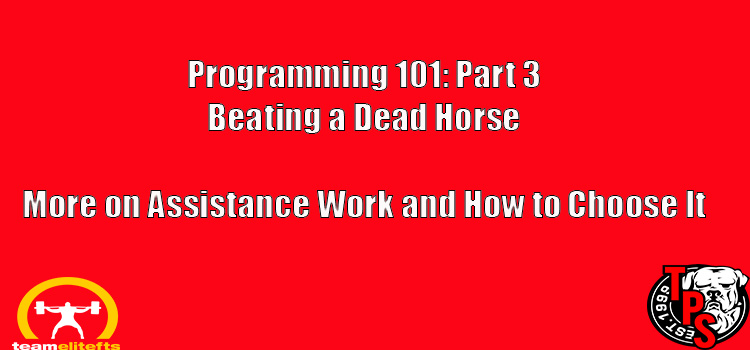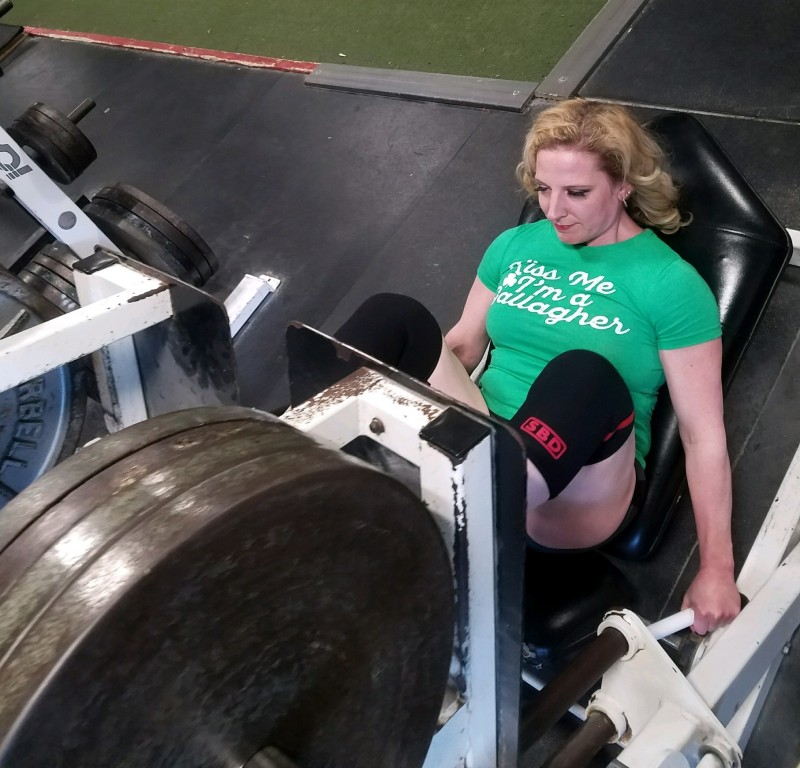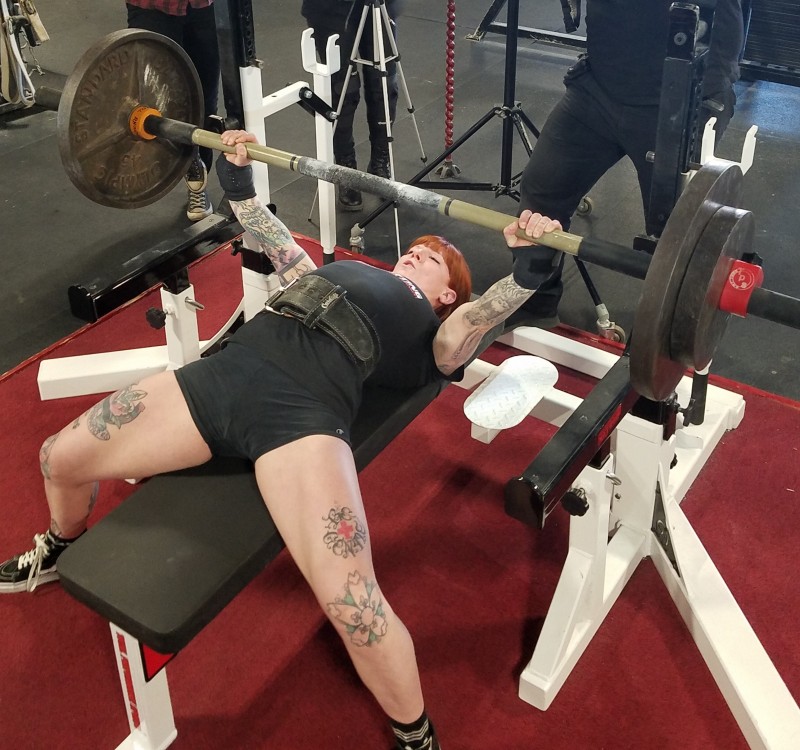
In the last installment of Programming 101 I reviewed the difference between Assistance and Accessory work for Powerlifting, and I gave some info on how to choose Assistance work.
Today, I am going to give you more food for thought on how and why to choose your Assistance work.
As a reminder, Assistance work is a lift done to build one of the three competitive lifts:
-
Squat
-
Bench Press
-
Deadlift
With that said, choosing the best Assistance work for you requires some thought and analysis by you, or you and your coach if you have one.
Video helps a lot here, so do training partners.
It is a great idea to video your sets and your lifts at meets.
This gives you concrete evidence of what is going on in your lifts.
Don’t be that guy, or girl who is constantly looking at the video and taking over the gym with your camera either. Just set it up out of the way and turn it on when you need to.
Review it after the session.
Pro Tip: Set your camera up at a 45 degree angle from the front or rear for best results.
After your session, watch the video and/or send to your coach and see where your form/technique breaks down.
Below is a list of some things to look for in each lift.
Squat:
- Depth-don’t kid yourself, are you there?
- Feet-are your feet active? Are they rolling in or out?
- Bracing-Are you?
- Knees-do they cave in, or are they out too far? Are they TOO far over your toes?
- Hips-are you initiating the movement with your hips or your knees?
- Chest-is it falling forward? Where? Out of the hole, at the mid point?
- Head-are you driving it back into the bar?
- Eyes-where are they? I am not a fan of looking down although it does work for some, most will be better with their gaze straight ahead or slightly upwards.
- Neck-is it cranked back hard? If it is, stop that right now.
- Elbows-where are they?
- Bar path-is it correct?
- Bar speed-is it slow? Fast?
- Plate feedback-do the plates snap at the top?
Bench Press:
- Receiving the bar-Are you reaching? Did you shorten your stroke? Are your elbows locked at the handoff? Did you settle the weight into your lats?
- Hips-are they as high as you can get them before you take the handoff? Are getting drive from them?
- Start position-are your joints lined up: shoulder, elbow and wrist.
- Ass-is it on the bench? Are you squeezing it?
- Knees-are you driving them out?
- Bracing-are you doing it?
- Feet-are they active? Are they in the best position for you?
- Bar path-is it correct for your style, type of bench? Are you keeping the bar in a path so that the weight is over your joints?
- Elbows-are the tucked too much? Flared too much? Just right?
- Head-are you lifting it off the bench as you perform the lift? Stop that.
- Chest-is it “up” throughout the lift?
- Lockout-is it strong? Are you holding it as if awaiting a rack command or are you just throwing it into the uprights too fast?
Deadlift:
- Start position-are your hips too high? Probably? Is the bar too close or too far from your shins? Are your hips too low? Maybe.
- Arms-are they long?
- Feet-are they active? Or are the rolling outwards?
- Bracing-again, are you?
- Shoulders-are they too far ahead of the bar? Too far behind?
- Do your hips and shoulders rise at the same rate?
- Are you hitching?
- Are you ramping?
- Are you driving your legs or using your lower back to do the lift?
- Are your knees locked at the finish?
- Are your glutes locked at the finish?
- Are your shoulders behind the bar at the finish?
- Are they too far behind the bar?
- Are you locking out with your legs and ass or using your lower back?
- Grip-is it even?
This is by no means a complete list, but it is a good start.
Alright then, we have some video and we gave it a look (NOT IN THE GYM!) and now we see what the issue is.
How do you fix it?
This is where choosing your Assistance work wisely falls into place.
In the last article I went over mostly how to write a program for a group, and not for addressing your own specific issues, or that of a specific athlete if you are a coach.
Today, we go over how it is done for an individual.
My answer is going to seem too simple.
It does not have to be harder than this.
When choosing the best Assistance work for an individual, you simply assign them an exercise that corrects their specific technique breakdown.
That’s it.
Cannot be simpler than that.
I’d love to finish the article here, but I feel we need a little more explanation.
After all, I did name this Programing 101: Part 3-Beating a Dead Horse.
In order to choose an Assistance exercise that corrects a fault, you need to understand why the fault was caused, and what exercises fix it, if it is not just shitty technique or the weight was too heavy.
Many times, fixing the fault will be best done by LOWERING the weight and COACHING technique.
This is usually truest with beginners, but it does come into play with ego lifters and those who like to overshoot RPE’s if you use them.
Let’s say that the lifter does follow the program, has pretty good technique and you need build the lift/portions of a lift, this is where the Art of Coaching comes into play.
I can’t possibly go over every single exercise and how to apply it, that is where you need to get experience as a coach, but I can tell you that there are many great resources on this, including this site.
If you don’t fully understand what Assistance lifts need to be used to build lifts, you better start reading.
When you do choose an exercise be sure to look at your lifter's flaw and figure out how to fix it. You also need to make sure that your volume and tonnage/intensity matches the rest of your training block, or micro cycle as the fancy kids say.
As an example, if you are in a Volume block it may be unwise to choose a second exercise that is a very high intensity for 1-3 reps. It doesn’t match the program.
Perhaps something in a higher rep range, maybe 3-6 is better.
Get it?
So, to sum it up:
- Watch your athlete lift.
- See where their technique breaks down.
- Figure out why.
- Assign an Assistance exercise that meets their CURRENT needs.
- Make sure the Volume and Intensity of their work matches the rest of your program.
- Don’t let them Ride Beyond Their Headlight.
I can go on for another 1000 words, but I’d rather have you start thinking and getting to work.
I hope this helps.
AND:
Good luck to TeamTPS who will be lifting at the RPS NH and Vermont State Championships this weekend.
I’ll be on the platform in the old man Bench Only division too.
Ask me a question-Be sure and Type to Murph in the header
Find me on Google-search for Total Performance Sports Malden, Mass. The Best Gym in Boston, Facebook too.
Oh, yeah, follow us on Instagram too. TPSMalden
SHARE THIS!
#bostonsstrongest
Vincere vel mori
By: C.J. Murphy
April 6, 2018












